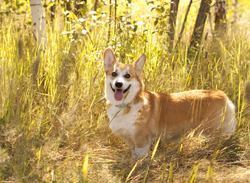Pembroke Welsh Corgis are small dogs with medium-length coats that come in sable, fawn, red, and black and tan, with or without white markings. The undercoat is thick, short, and weather resistant, and the outer coat is long and coarse. There is a longer ruff around the chest and neck. The ears are pointed and erect, and the eyes are medium and oval. These dogs have black noses and fox-like heads. Pembroke Welsh Corgis measure 10 to 12 inches tall at the shoulder and weigh 25 to 30 pounds.
The breed is loyal, brave, and naturally protective, partially due to their very strong herding instincts.
This breed is one of the most agreeable and friendly, making it a good choice for families. Pembroke Welsh Corgis do well in most living situations, although they thrive on and prefer farms. They enjoy participating in dogs sports, need regular exercise for physical and mental health, and require little grooming.
Pembroke Welsh Corgis are sometimes mistaken for Cardigan Welsh Corgis. These two breeds have different personalities and physical characteristics, though. Pembrokes are more outgoing and bubbly than Cardigans, and Pembrokes have a shorter body and lack a tail.
Pembroke Welsh Corgis are a quick-witted and active breed that requires a lot of physical and mental stimulation to remain healthy, happy, and well behaved. These dogs are amiable, fun loving, and great with children, although they tend to be a bit reserved with unfamiliar people.
The breed is loyal, brave, and naturally protective, partially due to their very strong herding instincts. In fact, their herding instinct is so strong that they tend to nip at heels to move children along and have been known to follow family members around, sometimes attempting to nudge them in one direction or another.
Inside, Pembroke Welsh Corgis are clean, quiet, and polite, provided they get plenty of affection and attention. Outdoors, these dogs are alert, active, and energetic. They excel in agility, flyball, rally, tracking, herding, obedience, and other dog sports.
Pembroke Welsh Corgis are known to suffer from a variety of health problems that may negatively affect length or quality of life. Some of these conditions are manageable with professional care, while others are potentially fatal, such as degenerative myelopathy, a type of progressive paralysis with no known cure. These dogs are also prone to obesity and attention should be given to activity levels and portion sizes.
Congenital hip dysplasia, intervertebral disc disease, hypothyroidism, epilepsy, and reproductive problems are all known to affect the breed. Additionally, Pembroke Welsh Corgis are at increased risk for von Willebrand's Disease, cryptorchidism, certain autoimmune diseases, skin fragility, urolithiasis, and certain types of cancer. Several eye problems, including progressive retinal atrophy, retinal dysphasia, persistent pupillary membranes, glaucoma, and lens luxation are also seen more often in this breed than in some other dogs.
When free of serious genetic disease, and when given proper nutrition, regular exercise, and routine veterinary care, Pembroke Welsh Corgis typically live 12 to 14 years.
Early training is an important part of caring for a Pembroke Welsh Corgi. These dogs can become nuisance barkers if not taught when barking is appropriate and when it is not. Also, Pembroke puppies must be taught how to climb up and down stairs due to their very short legs.
Positive reinforcement is an effective training tool, and Pembroke Welsh Corgis respond very well to praise, play, and food rewards. These dogs learn quickly, but they also bore quickly. Training sessions should be kept short and fun to avoid repetition. Firmness and consistency are also important.
Pembroke Welsh Corgis will run the household if not trained to back down. One of the easiest ways to manage the breed's behavior is by incorporating physical activity into the day's routine. Keeping the Pembroke's mind and body busy will reduce excess energy and help prevent most negative behaviors.
Pembroke Welsh Corgis have medium-length double coats that need twice-weekly combing and brushing to control shedding and reduce the amount of loose hair that ends up on furniture and clothing. Shedding is typically worse during the spring and fall, and brushing may need to increase in frequency during these times.
A gentle canine shampoo will remove any dirt or stickiness from the Pembroke's coat. These dogs do well with weekly baths, although bathing is really only necessary to remove harmful substances from the coat. A thorough rinsing will help prevent skin irritation.
The nails require clipping every couple of weeks to keep them from snagging and breaking. The Pembroke Welsh Corgi's teeth should be brushed daily to prevent bad breath, tartar buildup, cavities, and gum disease. Weekly ear cleanings help prevent wax accumulation and offer an opportunity to examine the ears for redness, discharge, odor, and other signs of infection.
Pembroke Welsh Corgis are a very old breed. These dogs developed from the same family that includes the Samoyed, Finnish Spitz, Keeshond, Norwegian Elkhound, Pomeranian, and Chow Chow. The breed's direct ancestors may have been brought across the Channel by Flemish weavers in the early 1100s. Pembroke Welsh Corgis hail from Pembrokeshire, Wales.
Although Pembrokes were primarily used to herd cattle, it's also likely they herded sheep and other animals. The breed has a lot in common with the Cardigan Welsh Corgi, but the two developed separately. In 1934, the two breeds were officially divided, and the Pembroke became one of the most popular dog breeds in the world by the 1960s. This surge in popularity was helped by the breed's celebrity status; Pembrokes were favorites of King George VI and Queen Elizabeth II.
No one is certain when this breed originated, but colorful stories exist to explain its appearance. The Welsh, for example, claim that these dogs were gifts from fairies, who rode them around like horses. The "saddle" on their back and white "harness marks" on their shoulders are evidence of this. Today, these dogs are primarily kept as companion animals around the world.
The American Kennel Club officially recognized the Pembroke Welsh Corgi in 1934.

